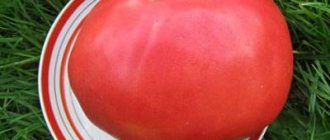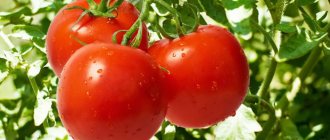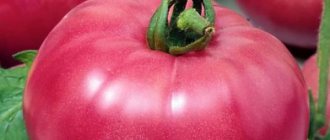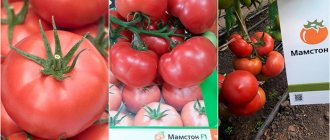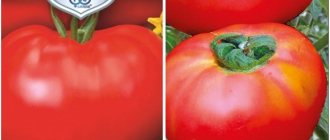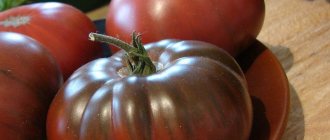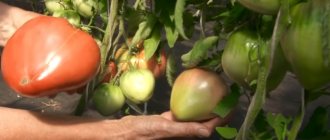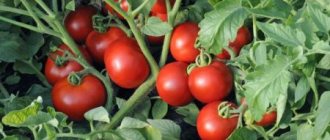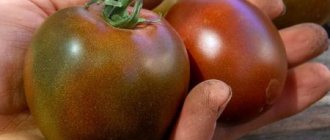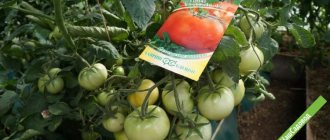Tomato King of Siberia - review
If you dream of the most productive orange-fruited tomato and feed yourself and your friends, then you will never regret if on your plot there is a tiny place for the best tomato KING OF SIBERIA.
Even without a lot of land, you can collect enough tomatoes from a small plot to be enough for everyone.
I have been growing tomatoes since 2012, since it is not a hybrid, I make the seeds myself.
SOWING.
I sow the seeds as early as possible in order to get MY FIRST TOMATOES as soon as possible. I grow it through seedlings. At first I sow the seeds thickly, and in the phase of 3-4 leaves I plant them in cups. In cups, my seedlings live up to 7 leaves, and sometimes even until buds form. In this state they will “migrate” to the garden bed.
You get a lot of seedlings, since you don’t mind your own seeds, this and that. I even give it to my friends so they can also enjoy such an amazing, rich, bright orange tomato.
ABOUT TOMATO.
The most delicious, sweet and durable tomatoes I have ever encountered are orange varieties. The plant is indeterminate, with unlimited growth, the bush is tall, a garter or support is required. The plant has few leaves, which has a beneficial effect on fruit filling and is easy to control.
THE KING OF SIBERIA is genetically resistant to diseases and therefore I try not to treat it with chemicals, so we use environmentally friendly fruits.
The variety is very resistant to temperature changes.
Very large fruits; if you form a tomato into one stem, you can get the first fruits over 500 grams.
For better pollination, I plant two tomato seeds of different varieties in a hole and form them into one or two stems so that they do not inhibit each other.
I plant tomatoes both in open ground and in a greenhouse, but I still prefer tomatoes grown in protected ground, they are much larger, juicier and more productive than in open ground.
The fruits are bright orange, fleshy, with a small number of seeds. I like to eat them just like that, they can be used as slices or in a salad. I recommend everyone to try THE KING OF SIBERIA, may you also have HOMEMADE PINEAPPLES on your table like mine))
Thank you for your time. Have a nice tomato harvest!!!
And here are some more reviews about the varieties I grow:
- the most nosed variety in my collection:
— meet my home PRESIDENT;
- strawberries that are irresistible
- the best, most productive orange variety from the AMATEUR COLLECTION.
Or maybe you are interested in my earnings on AIREK, then HERE
Tomato “King of Siberia” is a mid-early variety of indeterminate type. The copyright holder is agro. The crop is at the stage of experimental cultivation, which is why it is not on the State Register list.
Characteristics of the variety
Most often, the King of Siberia is a variety of indeterminate type, the bush of which reaches 180 cm (sometimes in greenhouses - 200-250 cm).
However, the tomato of the same name is positioned as determinate, with a height of up to 150 cm.
In any case, the plant needs to be tied up and formed into 1 or 2 stems. The fruits begin to ripen 110-120 days after sowing.
External description
Tomatoes are yellow or orange in color, large, and heart-shaped. The average weight of the fruit is 300-400 g (but some specimens from early harvests can reach 800-900 g or even more). The pulp is dense, non-watery.
The fruits are very tasty fresh. They can be eaten plain as a snack or used in slices and salads. They are not suitable for preservation due to their large size, and they do not contain enough liquid for making juice.
Productivity
On average, 5-6 kg of tomatoes are harvested from one bush. Productivity in greenhouses is an order of magnitude higher than in open ground. In addition, to improve performance, single-stem formation and additional fertilizing are used.
Sustainability
According to its characteristics, tomato resistance to cold is high: the King of Siberia variety calmly tolerates sudden weather changes and is rarely affected by late blight, tobacco mosaic and other fungal diseases.
However, insect pests pose a potential risk that requires preventative measures to reduce.
How to grow tomatoes
By June, the seedlings are ready to be transplanted into the ground. In greenhouse conditions, seedlings are planted 2 weeks earlier.
Landing
The soil is prepared 2 weeks before transplanting by digging and adding humus. They are transplanted into holes 15-20 cm deep, at the bottom of which a little sawdust or wood ash is first placed.
Planting pattern: 50 cm – distance between seedlings, 60 cm left between rows. For 1 sq. m place 3 plants in a checkerboard pattern. With this method, each bush receives a sufficient amount of light and is well ventilated.
After transplantation, the soil is compacted, watered with warm, settled water and the young bushes are left to get used to the new conditions for several days.
Further care
Regular watering is established no more than 2 times a week, water with warm, settled water at the root; tomato does not like watering leaves. Before fruiting begins, water abundantly, at least 5 liters of water per 1 seedling. When the ovaries form, watering is reduced, since excess moisture may cause the fruits to crack.
After watering, the soil is loosened, removing weeds with roots. Loosening saturates the root system with oxygen. To retain moisture in the beds, they are mulched with straw or peat.
This is especially important on dry days
The crop is fed three times per season: during flowering, at the time of ovary formation and during fruiting. A full complex of minerals or organic matter is used as fertilizers. Mineral fertilizers containing nitrogen are given 2-3 weeks after transplantation. Nitrogen helps plants grow green mass.
Fertilizers with a predominant content of phosphorus and potassium are given during the period of ovary formation and fruiting. Such fertilizing accelerates the ripening of fruits.
From organic matter, use mullein infusion or bird droppings in a ratio of 1:15. Such strong dilution is necessary so that the root system does not get burned.
Features of cultivation and possible difficulties
The indeterminate type requires mandatory staking of tall seedlings. The sooner you fix the stem to the support, the more powerful it will be formed. To do this, install a metal or wooden support next to each seedling and tie the stem to the support almost immediately after transplanting. In addition to the stem, fruit-bearing branches are fixed to the support as they grow.
The most convenient way of gartering is by fixing it to a trellis. Plants are fixed to a horizontally stretched wire with soft fabric tapes.
The culture needs regular pinching due to the large number of shoots. Stepchildren that have reached 5 cm are removed in the morning so that by the evening the wounds have time to heal. To prevent infection, the cut sites are sprinkled with ash or treated with a solution of potassium permanganate.
For maximum fruiting, the plant is grown in 1 or 2 stems.
Diseases and pests
Varietal characteristics include high resistance to diseases of the Solanaceae family. It is also immune to attacks from many pests. However, we should not forget about simple preventive measures, which include regular loosening, weeding, mulching and moderate watering. Agrotechnical rules recommend treating the beds with copper sulfate before planting tomatoes, which prevents fungal spores from developing.
In open ground, the Colorado potato beetle and its larvae are dangerous. Regular inspection of seedlings for the presence of the pest prevents the rapid proliferation of the parasite. Females lay larvae on the underside of the leaves, so careful inspection of the plants from all sides is necessary. If there are a lot of beetles, use the drug “Commander” or “Prestige”.
Characteristics of tomato King of Siberia
Tomato “King of Siberia” (pictured) is a productive variety that does not require special agricultural technology. It bears fruit consistently in any weather conditions and is undemanding to watering. The frost-resistant crop practically does not get sick and is not affected by insects.
Productivity and fruiting
The indeterminate variety of tomatoes “King of Siberia” is a productive one. High results are achieved due to the large mass of fruits. The formation of a bush with two shoots increases the level of fruiting and partially relieves the plant. The variety was created for cultivation in greenhouses and is adapted to a temperate climate zone. Ultraviolet deficiency does not affect photosynthesis and, therefore, fruiting.
Tomatoes are not afraid of a sharp drop in temperature; at +16 0 C the growing season does not stop. Increased humidity or its lack is perceived normally by the variety, the weight of the fruit does not change. In an unprotected area, it is recommended to plant the bush in a place shaded from the daytime sun. Excess ultraviolet light inhibits plant growth. In a greenhouse and open ground, 3 tomato bushes are placed per 1 m2, on average, up to 3.5 kg of fruit are obtained from one unit, which means the harvest is 10 kg.
Area of application of fruits
“King of Siberia” tomatoes are grown in summer cottages and small farm areas. Cultivated for commercial purposes. A mid-early tomato with good taste is in demand among consumers. At home, tomatoes are consumed fresh; they are included in vegetable stews. Smaller fruits are preserved whole. They look beautiful when mixed with red-fruited specimens.
Resistance to diseases and pests
The genetic basis of the “King of Siberia” tomato includes increased immunity against bacterial and fungal diseases. The variety does not suffer from tobacco leaf mosaic, late blight, or alternaria. Tomatoes are grown in cold climates, so most of the insects that parasitize the crop do not survive. Vegetable growers do not need to treat the plant against diseases with herbicides; the fruits ripen without additional chemicals. For the “King of Siberia” tomato in the southern regions, the larvae of the Colorado potato beetle pose a threat.
Advantages and disadvantages of the variety
The culture is relatively young, but it confidently occupies a leading position in growing exotic-colored tomatoes. According to reviews, the tomato variety “King of Siberia” has many advantages:
- High yield, stable fruiting, independent of weather factors.
- Tomatoes with exotic colors do not crack; they are fruits of universal use with excellent gastronomic characteristics.
- Due to their composition, tomatoes do not cause allergies.
- Fruits of technical ripeness ripen safely in a darkened room, retaining their taste.
- Easy to care for, medium-early ripening.
- Grows in greenhouses and open ground.
- Not afraid of pests and infections.
- A standard bush of an indeterminate type, does not take up much space.
The disadvantages of the variety include:
- the need to install trellises and garter bushes;
- unevenness of tomatoes from the first and subsequent bunches;
- gradual maturation.
Productivity
The King of Siberia variety is suitable for growing in greenhouses or greenhouses in the Eastern and Western regions of Siberia, as well as in the Far East or the Urals. If you plant a plant in the southern or central region of Russia, then using a greenhouse is completely optional. Gardeners successfully obtain a harvest even if the tomatoes are planted in open ground.
A sharp drop in temperature will not cause much harm to the tomato. If the reading on the thermometer is +16°C, then the growing season does not freeze. The presence of high humidity, as well as its lack, do not affect the weight of the fruit.
When planting in open soil, it is worth remembering that an area shaded from the daytime sun is best suited for the King of Siberia. Ultraviolet in large quantities will slow down the growth of the crop. Most varieties begin to suffer from fungal diseases during prolonged rains, but this does not apply to this plant.
The ripening of tomatoes is not simultaneous, which is quite a good quality, because you can get fresh vegetables for food throughout the entire fruiting period. The fruits ripen first from below, and last from above. If unexpected frosts are coming, then without any fear you can harvest the crop and put it in storage. There the tomatoes will ripen without completely losing their taste or beneficial qualities.
Other yellow-fruited tomato varieties:
The most productive varieties
Do you want to get the maximum yield of healthy orange-fruited tomatoes and feed not only your own family, but also your friends? From these varieties in one season you can get so many tomatoes from a small plot that there is enough for everyone.
Tomato King of Siberia. This variety has the most delicious and durable fruits, the weight of which reaches 700 grams. The plant produces the first ripe fruits already 3 months after planting the seedlings in the ground, which contain more sugars than other varieties. The bush requires garter, as it grows more than 1.5 meters tall. Due to the presence of genetic resistance to Alternaria, Cladosporiosis and tobacco mosaic virus, plants do not need to be treated with harmful chemicals, which makes the fruits environmentally friendly. Thanks to the combination of all these advantages, the King of Siberia tomato is rightfully considered one of the best varieties of orange tomatoes.
Orange Heart is a tomato with amazing heart-shaped fruits. Just like the King of Siberia tomato, it is a mid-season variety, and the first harvest is ready 85-90 days after planting the seedlings. Tall bushes require additional support to support the entire huge harvest of delicious fruits. It has the same disease resistance as the King of Siberia tomato, so you can easily obtain products for dietary nutrition.
The Orange Giant tomato was created for those who want to grow unusual fruits of huge size with an orange color. This variety is very whimsical and requires special care in the form of additional fertilizing. Ripe fruits have a low content of organic acids, so they can be eaten like apples straight from the bush, even by people with gastrointestinal diseases. Tall bushes with large fruits that reach 300g and above require support, but they are relatively resistant to disease. The fruit produces excellent orange-colored tomato juice with a taste incomparable to other tomatoes. The variety is mid-season with a yield of up to 5 kg per bush!
Fruit ripening
Tomatoes do not ripen at the same time, which is good - for a long time, the freshest vegetables come to the table directly from the garden. The lower fruits ripen first, and the upper ones last. In the event of an unexpected cold snap, Siberian tomatoes can be safely picked unripe. During storage, they will reach full ripeness, while remaining tasty and healthy.
The variety is a hardy plant and easily tolerates sudden changes in ambient temperature. Changes in air humidity are also not a problem. Noticeable cooling and prolonged rains do not cause fungal diseases. Resistance to pests is also noted. Many gardeners claim that this variety is not susceptible to diseases at all. So there is no talk about shortcomings in the reviews.
Advantages of the variety:
- large fruit sizes;
- their shape is almost the same;
- wonderful taste, abundance of nutrients;
- highest vitality;
- beautiful appearance.
Small-fruited tomatoes
Cherry and cocktail tomatoes are very similar, so they can be separated into a separate category - miniature tomatoes come in a variety of colors and have excellent taste characteristics. The weight of cherry tomatoes is 15-30 g. Cocktail tomatoes are slightly larger - their weight reaches 40-60 g. Small tomatoes have a universal purpose - they are eaten fresh or canned whole.
Granddaughter
The main stem grows to a maximum of 50 cm and does not need tying. The fruits are round, red, average weight - 20 g. Productivity - about 1.5 kg per plant. Under favorable weather conditions, it almost doubles.
Honey candy F1
This hybrid belongs to the mid-early category (110 days). The bush is low (80 cm), formed from 2-3 stems (they are fixed on a support). Up to 6 clusters are formed on each stem. Cherry shape is plum-shaped, color is yellow, weight is about 30 g. The taste is excellent. Productivity – up to 6 kg per 1 sq.m.
Chocolate bunny
The plant is powerful, reaches a height of 120 cm. Requires pinching. Productivity – up to 5 kg per 1 sq.m. The plum-shaped fruits have an excellent taste, weight – 30 g. When fully ripe, the color changes from red to chocolate. The harvest is well stored. Cherries make an excellent buffet appetizer; they can be canned or dried.
Black Cherry
The variety is very popular due to its sweet taste. The plant is powerful and enters the fruiting period after 120 days or a little earlier. It is disease resistant. Productivity is about 5 kg per 1 sq.m. A special feature is the increased need for fertilizing. The main part of the harvest is formed on the side shoots. Cherry color is almost black, weight is about 20 g.
Green Tiger
This variety allows you to get a cherry harvest with emerald pulp. The skin is colored light green, with darker stripes visible against the general background. The consistency of the pulp is dense, the taste is rich, very sweet. The weight of 1 tomato is about 30 g, up to 12 pieces are formed in each brush. The bush is unpretentious and tolerates changeable weather conditions. Average yield – 4-5 kg/sq.m. Stem height – up to 1.8 m (support required). Ripening takes 90-95 days.
Geranium Kiss (USA)
Cocktail variety. The bush is compact, low (50 cm). The fruits are oval in shape with a narrow “spout”. The pulp is dense and sweet. Green and brown tomatoes ripen without deteriorating in taste. They are removed from the bush in clusters. Transportability is good. The plant is disease resistant. Productivity is high - Geranium Kiss forms up to 5 clusters, each of which contains 60-100 fruits weighing about 40 g.
Cartridge
Patron is another variety of cocktail tomatoes. Productivity – up to 10 kg per 1 sq.m. The average weight of 1 tomato is 40-50 g. Color is red, shape is cylindrical. The pulp has excellent taste characteristics.
Bull's heart - large varieties of tomatoes
Many gardeners are familiar with this variety. Many people have long loved it for its extraordinary taste. Due to the lower water content, this tomato has a sugary pulp, very sweet and meaty. More often it is used fresh - in salads or juices. But for some types of canning this variety will be appropriate.
High-yielding species. The fruits ripen together, in large quantities. However, this variety is more prone to diseases than its competitors. It needs special care, feeding and plant treatment.
The bush is tall, up to 1 meter 80 centimeters. In greenhouse shelters, one bush can produce up to 13 kilograms of harvest. In open ground - 5-6 kilograms per bush.
Diseases and pests: prevention and control methods
The plant of this variety is immune to Alternaria, Cladosporiosis, and late blight. Resistance to diseases allows you to obtain environmentally friendly tomatoes, since there is no need to regularly treat plants with chemicals.
Tomatoes of the “King of Siberia” variety may be attacked by pests:
- spider mite,
- greenhouse whitefly.
A soap solution helps to cope with spider mites, which is used to treat the affected parts of the plant until the pest is completely defeated. When tomatoes are damaged by greenhouse whitefly, the bush is treated with the drug “Confidor” at the rate of 1 ml per 10 liters of water.
The variety “King of Siberia” is susceptible to brown spot. They fight it with the help of the drugs “Barrier” and “Barrier” or use a folk remedy - garlic solution.
Prevention of the disease consists of observing the light regime and maintaining optimal humidity.
Tomato King of Siberia: video
Getting the seed material of the King of Siberia is a very difficult task today, because the culture is only gaining its distribution. If you nevertheless acquire them and follow the necessary recommendations for cultivation and care, the result obtained will exceed all expectations in the good sense of the word.
I plant various varieties of tomatoes at my dacha and constantly try new types. In this article I will share my experience of growing one new product - the domestic original variety “King of Siberia”. This tomato boasts an unusual yellow color and impressive yield. Let's get to know the vegetable better, learn how to plant it and grow it.
The King of Siberia variety is classified as indeterminate. This means that the bush is not limited in its growth and can reach quite a decent height. To limit growth, gardeners prune the plant. The variety can be grown both in a greenhouse and under a film cover on the street.
Ripening time and yield
The King of Siberia tomato ripens in the mid-early period: from 100 to 115 days pass from the appearance of the first shoots to the ripening of the fruits.
As for the yield, it is approximately as follows:
- one bush produces 5 kg of fruit;
- About 17 kg of tomatoes are harvested from 1 m2.
Description of the bush
- Tomato King of Siberia has very strong, powerful stems
- Each stem is capable of forming several fruiting clusters. One brush produces 3-5 full-fledged high-quality fruits.
Description of fruits
In this case, the tomatoes have a very cheerful, cheerful color - light orange. This shade means that the fruits have a high content of beta-carotene, which is beneficial for the human body. A similar substance is also present in carrots and greatly helps restore vision.
The weight of one fruit can range from 300 to 400 grams, which is quite decent for tomatoes. There have been recorded cases of growing giant fruits of this variety, reaching a weight of both 700 and 1000 grams.
The shape of the fruit is round and attractive. The harvest is usually well stored and, provided that watering is reduced, does not crack. Note that the King of Siberia tomato is good for farm cultivation: it has excellent commercial qualities and tolerates transportation well.
- the fruits have a sweet taste;
- they contain many different microelements and organic acids that are beneficial to health;
Note that even allergy sufferers are allowed to eat the fruits of this variety of tomatoes. The product can also be used for children's and dietary nutrition.
Harvesting
Harvesting large yellow tomatoes should begin as they ripen - from August to the end of September. It is not recommended to leave a heavy harvest on the bushes, as the plant weakens. It is allowed to collect unripe tomatoes, which ripen well in warm, dry conditions at home.
The harvested crop is used to prepare salads, ketchups, sauces and salad preserves. Even though tomatoes do not give dishes a bright red color, they give them amazing taste and aroma.
Simple growing conditions, ease of care, high yield and excellent taste of the fruit contribute to the fact that tomatoes of the King of Siberia variety are gaining more and more popularity among domestic gardeners every year. The first fruits can be collected 4 months after planting, and good fruiting can be enjoyed until late autumn.
Watering
It is best to water the plants in the morning using warm water. When growing in greenhouses, it is worth setting aside a small corner in the room where a container for storing and warming liquid will be placed.
Tomatoes respond well to root watering and react very poorly to water getting on the foliage parts. As for the frequency of application of liquid, this is done once every 7 days. If we talk about the amount of water, then it all depends on the size of the tomatoes. For newly planted seedlings you will need 1 liter per bush.
14–21 days before the expected date of appearance of the first tomatoes, watering is reduced. This is necessary for faster formation of ovaries. Here, one liter of water is used per plant, once every 7 days. Then the amount of liquid needs to be increased again, but not to overdo it to avoid cracking the skins of the tomatoes.
As for growing the King of Siberia in an open area and watering it, the volumes and timing indicated above and recommended for greenhouse plants are maintained. The exception is when there is heavy rainfall, after which watering is not needed. You need to pick up a watering can at the moment when the soil is completely dry under the bushes.
- The King of Siberia tomato is unlimited in growth, that is, it belongs to indeterminate crops. The height of the main stem can reach two or more meters.
- The ripening time of fruits is average; the duration of the growing season before the appearance of the first fruits varies from 100 to 115 days.
- The tomato variety King of Siberia is adapted for cultivation both in open ground (under film cover) and in greenhouses.
- The stems of tomatoes are strong, and clusters with 3-5 inflorescences are formed on them. It is necessary to install supports or trellises to form and tie up the bush. Mandatory removal of stepchildren is required. It is recommended to leave, along with the main stem, another branch that grows from the stepson under the first branch.
- The fruits are of an unusual orange color. This indicates a significant content of beta-carotene in tomatoes, which is necessary for human health. The weight of one tomato ranges from 300 to 400 g, but giant fruits weighing 700 and 1000 g have already been recorded. If you look at the photo of a cross-section of a tomato, it resembles the shape of a heart.
- Tomatoes of the King of Siberia variety are tasty, sweet, and contain many useful microelements and vitamins. People who are susceptible to allergic reactions when eating red fruits can safely add these tomatoes to their diet. It is recommended to use them in baby food and dietary dishes.
- The yield of King of Siberia tomatoes has not been established by official data, but on forums amateur gardeners determine it in quantities of up to 5 kg per bush, or up to 17 kg per 1 square meter. m plantation.
- Tomatoes are consumed fresh and used for winter preparations in salads and mixes.
general description
This variety of tomatoes is a tall plant.
From the moment the seedlings are planted until the first frost, tomatoes grow to two or more meters in height. Full ripening of fruits from the day of planting seeds for seedlings occurs in 100-115 days.
Have questions?
Ask and receive useful advice from professional gardeners and experienced summer residents.Ask a question {amp}gt;{amp}gt;
The characteristics of the variety include growing vegetables in open ground and greenhouses.
The stems are strong, and clusters with three to five inflorescences are formed on them. The description of the variety states that the bush needs powerful support and the removal of stepsons. In addition to the main stem, another side branch is left, growing from the lower stepson.
The fruits are an unusual orange color. This feature is associated with a high content of beta-carotene, which is so necessary for the human body. In shape, as we see in the photo, the tomatoes resemble a heart, and their weight ranges from 300 to 400 grams.
The plant bears fruit well; there are already individual examples when some tomatoes gained weight from seven hundred grams to one kilogram!
King of Siberia tomatoes are rich in nutrients. Even people suffering from allergic diseases from red varieties of tomatoes can safely enjoy them. Fresh yellow and orange tomatoes are good for baby food and dietary dishes.
There are no official data on the yield of the new Siberian variety yet, but on gardening forums there are already reviews about the impressive fertility of these tomatoes. Some gardeners claim that they harvest up to 5 kg of large fruits from one bush. This means that with proper care, up to 17 kg can be obtained from one square meter.
It is better to eat them fresh. At the same time, they are suitable for canning and preparing all kinds of seasonings and sauces.
Characteristics of tomato King of Siberia
The King of Siberia tomato variety is well adapted to growing in Siberia. It tolerates short-term drops in temperature and drought. Therefore, even with minimal care it produces a consistently good harvest.
Tomato yield King of Siberia and fruiting
The tomato variety King of Siberia is a fruitful variety. Thanks to the large mass of tomatoes, 2.5-3 kg can be harvested from 1 bush, even in open ground. In greenhouse conditions, the figure is slightly higher - 3.5-4 kg per bush.
| Conditions | Greenhouse | Open ground |
| From 1 bush, kg* | 3,5-4 | 2,5-3 |
| From 1 m 2, kg | 10-12 | 7-8 |
*Yield calculations are based on the fact that 3 King of Siberia tomato bushes can be planted per 1 m2. This is quite possible, since the plants are compact and fit well even in a minimal area.
Yields are mainly affected by care and environmental conditions. Despite the fact that this variety of tomatoes does not require care, you can get more fruits from it if:
- grow in greenhouses or film shelters (including in the middle zone);
- water regularly (but do not over-moisten the soil);
- feed at least 2 times a month.
It is also recommended to periodically ventilate the greenhouse to prevent possible rotting.
Area of application of fruits
Tomatoes King of Siberia are a variety of universal purposes. They are consumed fresh, used in many dishes, as well as in homemade preparations for the winter:
- salads;
- soups;
- stew;
- sauces;
- canned vegetables (lecho, squash caviar).
Tomatoes are also suitable for pickling, but most of the fruits are very large. Each harvest contains small tomatoes, which are used for whole-fruit canning.
Resistance to diseases and pests
King of Siberia tomatoes have very good resistance to many diseases, including:
- tobacco leaf mosaic;
- Alternaria blight;
- late blight
Bushes are practically not affected by these infections. At the same time, an invasion of Colorado potato beetles and other pests cannot be ruled out. Therefore, if necessary, the bushes must be inspected. If pests are detected, you should immediately treat with insecticides or folk remedies.
Advantages and disadvantages of the variety
King of Siberia tomatoes have significant advantages. The variety produces stable yields even in difficult climatic conditions.
3-4 large tomatoes are formed on 1 brush
pros
- consistently high yields;
- excellent taste of tomatoes;
- hypoallergenic composition;
- can be grown in greenhouses and open ground;
- good immunity to fungal and viral infections;
- resistance to temperature changes and short-term drought.
Minuses
- large fruits are difficult to pickle for the winter;
- the need to form a bush (stepping);
- needs to be tied to a support.
Caring for tomatoes in open ground
Caring for King of Siberia tomatoes is common and involves following the traditional rules of agricultural technology: timely watering and fertilizing, weeding, pinching and professional pest control.
Important! Seedlings are planted only when at least 5–6 leaves have formed on the stem.
Watering
The variety loves good, abundant, but rare watering. It is recommended to water the bush in the evening or on cloudy days, 2-3 times a week, completely soaking the top layer of soil. Watering is carried out directly into the holes using settled, not cold water. The earthen clod should not be allowed to dry out too much, as in this case the plant will begin to dry out and slow down growth, which will negatively affect the development of fruits and the yield of the vegetable.
It is mandatory to moisten the soil during the flowering phase of the tomato, after loosening the soil and the stage of fruit ripening. In greenhouse growing conditions, experts advise organizing drip irrigation, which will allow you to control the degree of soil moisture.
Fertilizer application
King of Siberia tomatoes can produce a good harvest only if they are fertilized with high quality and on time. It is recommended to combine fertilization with watering once a month. As fertilizers, you can use organic (manure, droppings) and mineral products with phosphorus, potassium and nitrogen.
Learn how to feed tomatoes with yeast.
It is recommended to take care of staking the bushes in advance, since the heavy fruits will begin to lean toward the ground. For gartering, you can use wooden or plastic pegs, which must be inserted from the northern part of the bush at a distance of 10–12 cm from the stem and tied with a strong but elastic material.
Soil care
To increase the yield of a plant, it is imperative to loosen the soil and weed it from weeds. The first event will saturate the soil with oxygen, thereby accelerating the flow of nutrients into the root system. The first loosening should be carried out after planting the seedlings, going 10 cm into the ground. Subsequent loosening should be carried out systematically as needed. Simultaneously with loosening, you should weed the bed to remove weeds.
Mulching is considered an excellent prevention of weed development, which is carried out by placing various organic and inorganic materials on the ground under the bushes - straw, sawdust, sand. Mulch also allows you to retain moisture in the soil, prevent its evaporation, and simplify the process of watering vegetables.
Forming and tying bushes
Since the King of Siberia variety is a tall plant, the bush is formed into only one, or maximum two, stems. In this case, every 10 days you should remove all lateral shoots that have reached a length of 3–4 cm. At the same time, you need to remove several lower leaves, which “take away” nutrients from the plant. Removing stepsons allows you to strengthen the plant, activate the development of fruits, thereby improving productivity.
Did you know? When cooked, tomatoes not only do not deteriorate their beneficial qualities, but also improve them. So, for example, the amount of lycopene, a pigment responsible for rejuvenating the body, increases by a third after two minutes of cooking.
Recommendations for cultivation
Germinate seeds for seedlings with the onset of calendar spring. When two young leaves form on a sprout, immediately transplant them into peat cups.
We invite you to familiarize yourself with: Serpentine variety cucumber description
10 days before planting seedlings in the ground, harden them, each time increasing the time spent in the open air.
Plant only seedlings that have at least 5 leaves and one flower cluster. This usually occurs 2 months after planting the seeds.
Three or four bushes grow on one square meter of soil, no more. The distance between bushes and rows should be at least 50 cm.
Leave only two stems on each bush and cut off the rest. Leave the second stem, which was formed from the stepson under the lower brush. Stepchildren grow back, so prune them regularly until harvest is complete.
Feed the King of Siberia tomatoes twice during the entire period of their cultivation. To do this, use only liquid complex mineral fertilizers.
Water the tomatoes as needed - after sunset, using warm, well-settled water.
Like any other tomato variety, the King of Siberia loves regular loosening and weeding of the soil.
As you can see, caring for this variety of tomatoes is not so burdensome. If you follow all the tips, the harvest from each bush is guaranteed.
Olga Danilina
Characteristics
This tomato has a truly royal appearance. The fruits are orange, heart-shaped, slightly flattened. The fruits are very fleshy, large from 400-700 grams, there are also real giants whose weight reaches 1000 grams. The fruit has 7-9 chambers and contains little water. The amount of dry matter is 3-5%.
You can compare the weight of tomatoes of this variety with others in the table below:
| Variety name | Fruit weight (grams) |
| King of Siberia | 400-700 |
| Russian size | 650-2000 |
| Andromeda | 70-300 |
| Grandma's gift | 180-220 |
| Gulliver | 200-800 |
| American ribbed | 300-600 |
| Nastenka | 150-200 |
| Yusupovsky | 500-600 |
| Dubrava | 60-105 |
| Grapefruit | 600-1000 |
| Golden Jubilee | 150-200 |
This type of tomato was bred in Russia by our Siberian scientists. It received registration as an independent variety in 2014.
As the name suggests, this type of agricultural crop is intended for cultivation in greenhouse conditions in the regions of Western and Eastern Siberia, the Urals and the Far East. But it can be grown in open ground in the central and southern regions of Russia.
The fruits of the King of Siberia variety are very good for fresh consumption. Not suitable for preservation due to its large size. Extracting juice from them is also problematic, since they contain little moisture.
King of Siberia tomatoes are distinguished by very high yields. With proper care, you can collect up to 5 kilograms from one bush, and from sq. meters up to 12-15 kilograms.
You can compare the yield of the King of Siberia with other varieties in the table below:
| Variety name | Productivity |
| King of Siberia | 12-15 kg per square meter |
| Andromeda Pink | 6-9 kg per square meter |
| De Barao the giant | 20-22 kg per bush |
| Polbig | 4 kg per square meter |
| Sweet bunch | 2.5-3.2 kg per square meter |
| Red bunch | 10 kg per bush |
| Summer resident | 4 kg per bush |
| Fat Jack | 5-6 kg per bush |
| Pink Lady | 25 kg per square meter |
| Countryman | 18 kg per bush |
| Dad | 6 kg per bush |
| Golden Jubilee | 15-20 kg per square meter |
REFERENCE: To increase the mass of fruits, experienced gardeners leave 4-5 flowers on one branch.
Application
Tomatoes of the “King of Siberia” variety are best consumed fresh, in the preparation of salads, as well as first and second courses. These fruits are ideal for dietary nutrition and feeding children, due to their high content of vitamins and beta-carotene. These tomatoes are not recommended for making juice due to the low water content in the fruit.
It is also inconvenient to use them for preservation, since tomatoes of this variety are large.
The “King of Siberia” tomato fully lives up to its loud name. Thanks to its unique characteristics, this variety occupies one of the leading positions among tomatoes grown by experienced gardeners in our country.
Tags: king, description, Siberia, variety, tomato, characteristics
About the author: admin4ik
« Previous entry
Characteristics of fruits and bushes
Tomato King of Siberia is an indeterminate crop. The plant is quite tall, vegetable bushes can reach a height of 160-180 cm. The leaves are sparse, but large, reminiscent of maple in shape.
The stems of the King of Siberia tomatoes are powerful and strong. On each of them, brushes are formed, dotted with 3-5 inflorescences. The plant must be tied up, installing supports (trellises) near each bush. In addition to the main stem, one lower branch is left on the bush (from the stepson of the first daughter branch).
The fruits of the King of Siberia variety have a rather unusual color - yellow-orange. It is caused by the high content of beta-carotene in tomatoes (a component that is extremely beneficial for human health). The weight of one fruit reaches 300-400 g, but there are also larger specimens weighing 700-1000 g. The shape of tomatoes in cross section resembles a heart, the fruits are fleshy and juicy. Tomatoes have a sweetish taste and contain a large amount of vitamins and microelements.
Productivity and method of use
There is no official information on the yield of King of Siberia tomatoes. But reviews from gardeners indicate that up to 5 kg of ripe, tasty and aromatic fruits can be harvested from one bush (up to 17 kg of tomatoes can be obtained from 1 sq.m of plot area). To increase the mass of tomato fruits, some gardeners keep 4-5 flowers on one branch during the flowering period.
People allergic to red tomatoes can add King of Siberia tomatoes to their diet. They are also suitable for dietary and baby food. It will not be possible to make juice from them for the winter, because the moisture content in the fruits is minimal. King of Siberia tomatoes are consumed fresh, as part of salads or winter preparations.
Strengths and weaknesses of the variety
Advantages of King of Siberia tomatoes:
- unpretentiousness to the place of growth and soils;
- high yield;
- good resistance to diseases and pests;
- the culture adapts well to different climatic conditions;
- excellent aromatic and taste properties;
- tomato fruits of the King of Siberia variety are stored for a long time and are well tolerated
- transportation over long distances.
- fruits can be used only in limited areas of cooking and only fresh; the plant needs to be watered regularly and abundantly;
- There are special nuances in caring for King of Siberia tomatoes (for example, special strong supports must be made for the branches).
In order for the harvest of this variety of tomatoes to be excellent and high, the gardener must know the peculiarities of cultivating the vegetable crop.
"Orange King of the Market 13 F1" or "Gold King"
They renamed the beautiful hybrid “Golden King” to orange, and number 13, which since 2010 has been pleasing vegetable growers with its beautiful fruits.
The tomato is included in the register of breeding achievements of the Russian Federation under number 8954018.
The originator and applicant of the variety is LLC Agrotechnological Novosibirsk district, village Izdrevaya Russia.
The tomato is recommended for cultivation in all regions of the Russian Federation in film shelters and unheated greenhouses of vegetable growers’ private farms.
Orange King of the Market 13, or rather “Golden King” is a hybrid for salad purposes, medium ripening.
The plant is low-growing, determinate.
The leaf blade makes the hybrid recognizable because it has a very light green color. Novice vegetable growers, not understanding the intricacies of the hybrid, believe that the leaf indicates nitrogen deficiency and begin intensive feeding, but these are just biological features.
The fruit of the hybrid is heart-shaped. During the ripening period, the tomato retains a green spot at the base of the stalk for a long time. As biological ripeness increases, the spot disappears and the fruit turns yellow.
Faint ribbing adorns the “golden king”. The tomato is average in density, has 6 and sometimes more nests filled with pulp.
The tomatoes are leveled, weighing about 200 g, with a good marketable yield.
The tomato taste is balanced. The tasters' rating is "good", but vegetable growers note the taste of the fruit as "excellent".
It should be noted that the variety is not very “promoted”, but meanwhile, those who grew it once note:
- high productivity;
- long, extended fruiting;
- excellent resistance against diseases;
- high taste qualities.
Having planted “Golden King” tomatoes in the garden and experienced all the delights of the hybrid, vegetable growers are surprised why this “gold” is not yet in demand by the broad masses, but this tomato deserves its name “king of the market tomatoes.”
Some vegetable growers compare the “Golden King” with the hybrid “King of Siberia”. However, the "King of Siberia" is not on the register and is of unknown origin, and is marketed as an indeterminate, tall-growing variety, while the "Golden King" does not exceed 80 cm, making it much easier to care for.
Conditions for growing tomatoes
“King of Siberia” is a variety that is suitable both for open ground and for planting in a greenhouse. For central Russia, as well as Siberia, the Urals and the Far East, the greenhouse option is preferable. In northern conditions, sowing of seeds for seedlings begins already in the first half of March. The following growing conditions must be observed:
- The soil is prepared by treating the soil with a weak solution of potassium permanganate, tamping it and leaving it warm overnight.
- When planting, it is necessary to mulch the top layer with centimeter-high peat and spray with warm water.
- Before germination, the seeds must be covered with film and left at a temperature of at least 25º.
- When sprouts appear, the film is removed and the plants are moved to a well-lit place, for example, on a windowsill.
- It is recommended to keep the sprouts during the first week at temperatures up to 15º.
- Further growth of seedlings occurs at room temperature, absence of drafts and timely watering.
- When two true leaves are formed, a pick is made.
- 10 days before planting in the soil, it is advisable to begin hardening off the plants.
The “King of Siberia” seedlings are planted in mid-May under film or in early June in open ground. At this time, the plant should have at least 5-7 leaves and, preferably, a flower cluster. Gardeners often note that seedlings begin to bloom even before planting in the soil.
Growing seedlings yourself
Their productivity will certainly depend on the quality of tomato seedlings, so experts recommend growing seedlings yourself.
Sowing seeds for seedlings should be done at the end of February - the first half of March. It is better to use purchased seed material, since due to the hybridity of the variety, it will be quite difficult to obtain seeds from previously collected fruits.
Important! Tomato fruits contain too little moisture and are therefore not suitable for obtaining tomato juice.
The soil
King of Siberia tomatoes are not demanding on the composition of the soil mixture, however, to grow strong and high-quality seedlings, it is recommended to prepare soil from:
- 1/3 bucket of garden soil, humus and compost;
- 1 kg of fine sand;
- 0.5 kg of ash;
- 50 g each of superphosphate and ammonium nitrate.
We invite you to familiarize yourself with: New Year's COMPOSITIONS - 55 photo ideas for decorating your home.
All components of the mixture must be thoroughly mixed and placed in a dry, frost-free place to settle for two weeks. Soil from the garden, mixed in equal proportions with humus, is also suitable as soil for planting seedlings. It should be noted that any non-purchased soil should be disinfected from possible parasites and pests.
For disinfection you can use the following methods:
- calcine the soil in an oven for 20 minutes at a temperature of 180... 200 °C;
- Sprinkle the soil with a concentrated solution of potassium permanganate and let it dry.
You can sow seeds in any container available on the farm. This can be general containers, for example, plastic or wooden boxes, or individual containers - disposable plastic cups, decorative flower pots, etc. You can also use special boxes - cassettes or peat tablets. The latter are considered the most optimal option, since they can subsequently be planted along with seedlings.
Important! Immediately before planting the seeds, the soil should be brought into the house or apartment and left overnight in a warm place. You cannot sow seed in unheated, cold soil.
Seed preparation
It is recommended to purchase King of Siberia tomato seed material in specialized stores in order to be sure of its quality. Before sowing seeds, they must be disinfected and warmed.
To do this you should:
- soak the seed material in a weak solution of potassium permanganate (0.1 g of potassium permanganate per 100 ml of water) for 15–20 minutes;
- rinse the seeds through a sieve with plenty of water;
- place in a damp cloth and wrap in a plastic bag;
- place the seeds in a warm, dry place, with a temperature of 24... 26 °C.
Such measures will make it possible to neutralize the seeds from possible pests, and will also strengthen the immunity of the sprouts, activate their growth and improve fertility rates.
Sowing seeds
After completing the preparatory work, you should begin planting the seeds. You need to pour the primer mixture into the container, compact it slightly and place the seeds on top without a depression, at a distance of 2–3 cm from each other. In this case, the interval between the grooves should be about 3–4 cm.
Next, you need to sprinkle the material with a small layer of earth and moisten the surface with a spray bottle. When the soil settles a little, the future seedlings should be covered with plastic film and taken to a warm, dry place.
Important! After 3–4 days, all high-quality seeds will hatch; it is recommended to sow them.
Seedling care
For high-quality germination of seedlings, it is necessary to organize conditions as close as possible to greenhouse conditions:
- Temperature. Immediately after sowing the seeds, the container with seedlings should be placed in a warm, dry place where temperatures vary between 24...26 °C. The container must be kept under the film until the first shoots form. Next, the seedlings need to be opened and moved to a well-lit place. During the first week after germination, it is not recommended to change the temperature in the room, and only after 7 days it is recommended to lower it to 15 ° C, and then gradually raise it to room temperature. Such a temperature jump will harden the plants and prevent them from stretching upward.
- Lighting. It is preferable to grow seedlings in a well-lit place where there is no direct sunlight. The optimal length of daylight for sprouts is considered to be 12 hours, so if there is a shortage of light, it is necessary to install an additional lighting source, using, for example, fluorescent lamps.
- Watering. It is necessary to water the sprouts as the soil dries. It is better to simply spray the surface of the earth with a spray bottle. It is not recommended to allow the soil to become waterlogged, as this can cause rotting of the root system.
- Feeding. When caring for seedlings, do not forget about fertilizing. The soil should be fertilized for the first time two weeks after the sprouts appear, then every week until planting. Liquid fertilizers based on potassium and phosphorus are perfect for feeding.
A mandatory procedure before planting seedlings in open ground is their hardening, which begins two weeks in advance. Hardening allows you to strengthen the plant’s immune system, make it easier to adapt to new environmental conditions, and activate its growth and development.
Important! At the stage of two fully formed leaves, you need to dive the seedlings into separate containers.
The procedure for hardening seedlings is carried out according to the following algorithm:
- the temperature in the room where the container with sprouts is located must be reduced to 12... 15 degrees in 1.5–2 weeks;
- It is recommended to gradually reduce the temperature until it is equal to the ambient temperature;
- in parallel with the decrease in temperature indicators, the frequency of watering should be reduced, leaving the volume of watering the same;
- 1–2 days before planting, the seedlings should be taken out into fresh air and left for several hours;
- Immediately before planting, the sprouts should be left in the fresh air overnight.
Red varieties
Red tomatoes are in greatest demand. They have a variety of characteristics - different taste, shape, size. Most varieties have a universal purpose.
Sparkle
Cream tomatoes are great for canning. Fruit weight – 110 g, stem height – 55 cm. Features: excellent keeping quality, ability to withstand transportation with virtually no loss.
Seedless
One of the advantages is the early ripening period (on average 87 days). An equally important factor is the unpretentiousness of the plant - the harvest can be obtained even under unfavorable weather conditions. The next advantage is the possibility of using it both fresh and for preparing canned tomatoes. Weight of 1 tomato – up to 200 g.
Boni MM
The plant is ultra-early ripening - the harvest ripens within 85 days (non-seedling planting is possible). Fruiting is limited in time - it takes 15-20 days. Boni MM is grown in any region of Russia. The bushes are compact and can be planted in a compact pattern. There is no need for pinching or staking (the stems are low - only 50-60 cm).
Two- or three-chambered round tomatoes near the stalk have a ribbed structure. The peel is elastic, but thin, the taste of the pulp is sweet and sour. Average weight - 85 g. Plants are resistant to late blight, each produces up to 2 kg of tomatoes. The purpose is universal.
Kolkhozny
Even under not the most favorable conditions, the drought-resistant low-growing plant produces a harvest. Each bush brings 3.5-4 kg. An additional benefit is excellent immunity to disease. The tomatoes are smooth, with loose flesh, strong skin, do not crack, and are suitable for transportation over long distances. Average weight – 80-100 g. The taste is pleasant.
Siberian early ripening
This old selection variety is popular due to its high yield (up to 7 kg per 1 sq.m.) and early ripening. The height of the stem is up to 50 cm, no molding is required, but a garter to the stakes is required. Weight – 110-150 g, the skin is tender, the sourness is noticeable, but sweet notes predominate. The plant tolerates adverse weather conditions well and has high resistance to disease. The purpose is universal, but during canning the skin bursts.
Sanka
Sanka is a universal, ultra-early, low-growing variety (30-60 cm), suitable for dense plantings. Requires stepsoning. The stems do not need garter. The fruits are round, slightly ribbed, weighing up to 90 g each. The pulp is aromatic, juicy, the taste characteristics are average, the skin is dense. The purpose is universal (any processing methods can be used). Keeping quality/portability is good. Productivity – up to 2.5 kg per bush.
Tsarskoselsky
The variety is early ripening (103-105 days from the moment of germination), universal purpose. The height of the bushes is 100 cm. The fruits have excellent taste characteristics. Their average weight is 90-100 g. The harvest is formed smoothly, transportability and keeping quality are good. From 1 sq.m it is possible to get 8.5-9 kg of tomatoes.
Kaspar 2 F1
Low growing hybrid. Tomatoes are suitable for any type of processing and can also be eaten fresh. They have a cylindrical shape. Average weight - 85 g. The pulp is dense, the skin is rough. Due to this, the resulting crop can be transported over long distances. Keeping quality and ability to ripen are additional advantages of the hybrid. The plant has average resistance to disease, which is the only drawback.
